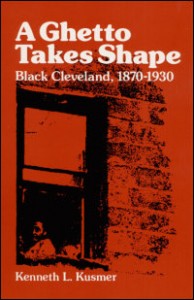A Ghetto Takes Shape
http://www.press.uillinois.edu/books/catalog/59dqc8kx9780252006906.html
 A Ghetto Takes Shape: Black Cleveland, 1870-1930 by Kenneth Kusmer
A Ghetto Takes Shape: Black Cleveland, 1870-1930 by Kenneth Kusmer
In 1865, the Cleveland Leader boasted that “an indication of the civilized spirit of the city of Cleveland is found in the fact that colored children attend our schools, colored people are permitted to attend all public lectures and public affairs where the fashion and culture of the city congregate, and nobody is offended.” Yet, by 1915, the Central Avenue district of town, with its cheap lodging houses, deteriorating homes, and vice, housed a majority of the black population under conditions that were decidedly inferior to those of most of the rest of the city.
Tracing the development of Cleveland’s black community from its antebellum beginnings to the end of the 1920s, Kenneth Kusmer systematically surveys and analyzes the emergence of the ghetto in the city where, prior to 1870, blacks were “almost equal” to whites. This volume deals in a comprehensive way with more aspects of black life – economic, political, social, and cultural – than any previous study of an urban community and presents the most detailed analysis of black occupations available. It is also the first work to make extensive use of manuscript collections of local black leaders and organizations.
Of particular value is the comparative framework of the study. Kusmer compares the position of blacks in the social order with that of immigrants and native whites and places the development of the ghetto within the context of urban history. In addition, by contrasting Cleveland with other major cities, such as New York, Chicago, and Boston, Kusmer shows that there were important differences among black communities, especially before 1915, and proves that the causes and effects of the emergence of black ghettos are more complex historical problems than previously recognized.
The consolidation of Cleveland’s ghetto took over fifty years, and it left the average black citizen more isolated from the general life of the urban community than ever before. Yet, ironically, Kusmer concludes, it was this very isolation, and the sense of unique goals and needs that it fostered, that helped unify the black citizenry and provided the practical basis for the future struggle against racism in all its manifestations.

